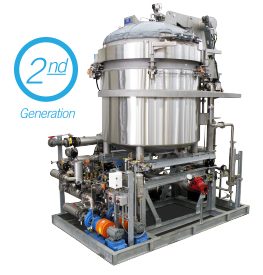Compare Digester Systems

How Does Tissue Digester Technology Work?
Tissue Digesters accomplish two primary tasks: sterilization and destruction of tissue and proteins. They utilize heat, agitation and pressure to break down and sterilize tissue, and can also employ a caustic chemical action as desired. The result of this process is a high level of destruction and molecular breakdown of proteins/other components that is not possible with other technologies. Proteins are hydrolyzed into small chain polypeptides and amino acids, with many amino acids destroyed.
The result is an isotonic, biologically inactivated solution of peptides, amino acids, soaps and electrolytes. This waste can then be either sent as water waste to municipal sewer entirely, or separately as a dry discharge. Tissue Digester technology offers many benefits over alternative technologies, including:
- cost-effective
- compliance with published Prion guidelines
- reduced liabilities; in-house processing
- reduced personnel handling and transport
- designed for containment as well as non-containment facilities
- automated process for assurance of consistency
- process validation controls and reporting
Alkaline Hydrolysis (Gen 2): tissue is placed in a vessel that is then filled with a mixture of water and alkali, and heated to a temperature around 160 °C (320 °F), at a high pressure. Tissue is broken down, and bones are collected while liquid is disposed of as sanitary municipal waste.
Thermal & Physical Degradation (Gen 3 Thermal Tissue Digester): a revolutionary advancement in tissue disposal and sterilization, using agitation and heat to break down tissue (with or without alkali), minimizing water and caustic use in the process. Tissue and bones are broken down and disposed of as liquid through sanitary sewer or collected as dry discharge for municipal waste.
Compare 2nd Gen vs. 3rd Gen Digesters
 |
 |
|
Caustic Digester Unit™ |
Thermal Tissue Digester™ |
|
| Process Liquid Recirculated Outside Vessel | ✔ | contained within vessel |
| Internal Agitation of Tissue Inside Vessel | no agitation | ✔ |
| Manual Removal of Remnants Via Basket | ✔ | no removal necessary |
| Batch Reporting System | ✔ | ✔ |
| Capable of Dry Discharge | liquid only, remnants in basket | ✔ |
| Effluent BOD to sewer | High | Low |
| Water consumption | High | Low |
| Caustic Volume & Usage | High | Low |
| Caustic Costs | High | Low |
| Total Disposal Costs | High | Low |
Categories & Tags
ISO 9001:2015

